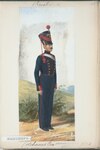Lithuanian Separate Corps

The Lithuanian Separate Corps (Russian: Литовский отдельный корпус, romanized: Litovskiy otdel'nyy korpus, lit. 'Lithuanian Separate Corps', Lithuanian: Lietuviškasis atskirasis korpusas, Polish: Korpus Litewski) was a corps of the Imperial Russian Army, created in 1817.[1][2] After the Russo-Turkish War (1828–1829), the Lithuanian Corps was renamed as the VI Corps.[1][3] The Lithuanian Corps was disbanded in 1831 after the Polish–Lithuanian Uprising of 1831.[2]
The corps, except for the guard units, was recruited from Lithuanians and Poles, which set it apart from the rest of the Imperial Russian Army.[3] The guard units were recruited mostly from Russians.[1]
Formation[edit]
The Lithuanian Corps was formed on 1 July 1817 by Tsar Alexander I of Russia who made Grand Duke Konstantin Pavlovich of Russia its commander as the latter was already the commander of the Army of Congress Poland.[1][2] The Lithuanian Corps recruited in the five provinces of Vilna, Grodno, Minsk, Volhynia and Podolia and Belostok Oblast, all of which together made up the Russian Empire's so-called Western Krai.[2] The Corps was widely stationed throughout the territory of the governorates of Volhynia, Minsk and Grodno.[2]
The Lithuanian Corps consisted of 2 infantry divisions, each containing 2 brigades, 2 artillery brigades as well as guard and grenadier regiments.[2] Together with the Polish Guard, the Lithuanian Corps' Guards and Grenadiers regiments formed the Guard Reserve Corps, also established in 1817.[2] The Guard Reserve Corps was stationed in Congress Poland and was commanded by General Wincenty Krasiński.[2] The unit was disbanded in 1831.[2]
Composition[edit]
When it was created on 1 July 1817, the corps consisted of these units:[1][3]
- 27th Infantry Division
- 28th Infantry Division (previously the 4th Infantry Division)
- 29th Artillery Brigade
Then other military units were included in its composition in 1817, including the newly-formed regiments such as the:[1]
- Lithuanian Life Guards Regiment
- Volhynian Life Guards Regiment
- Podolian Cuirassier Regiment
- Tsarevich Konstantin Pavlovich Uhlan Regiment
- Polish Grenadier Regiment
- 1st Lithuanian Grenadier Regiment
- 2nd Lithuanian Grenadier Regiment
- Lithuanian Carabinier Regiment
In 1818, the 1st Uhlan Division, consisting of the following uhlan regiments: Polish, Tatar, Lithuanian and Volhynian, was renamed as the Lithuanian Uhlan Division and included in the Lithuanian Corps.[1]
On 19 April 1819, the Lithuanian Artillery Division was formed from the 27th and 29th Artillery Brigades.[1] On August 10 and 17 October, new separate batteries were formed for the corps, which were the Life Guards Horse Artillery Battery №3 and the Life Guards Foot Artillery Battery №5.[1] Two years later in 1821, these batteries, together with batteries №1 and Light Grenadier №2, formed the Combined Guards and Grenadier Artillery Brigade of the Lithuanian Corps.[1]
On 20 May 1820, the 27th and 28th Infantry Divisions were renamed the 24th and 25th.[1] That same year on September 10, a special supply brigade was formed for the Lithuanian Corps on September 10.[1] In 1824, the Grodno Life Guards Hussar Regiment was formed for the Lithuanian Corps.[1] Finally, the Lithuanian Pioneer Battalion was formed under the corps.[1]
On 25 March 1825, the 1st and 2nd Lithuanian Grenadier Regiments were renamed as the Samogitian and Lutsk Grenadier Regiments, while the Lithuanian Carabinier Regiment was renamed to the Nesvizh Carabinier Regiment.[1]
Uniforms[edit]
All infantry of the corps had a silver device, yellow collars, cuffs and piping (the guards and grenadiers also had yellow lapels) and black leggings.[1][3] The Uhlan division was also distinguished by its silver equipment, and the applied cloth on its uniforms and caps on the regiments was crimson, white, yellow and blue.[1] The artillery had black lapels, while its officers had velvet lapels.[1]
- Uniforms of the units of the Lithuanian Corps
-
Drummer of the Lithuanian Pioneers in 1826
-
Musician of the Lithuanian Life Guards Regiment in 1826–1828.
-
Artilleryman of the Lithuanian Artillery Division in 1826
-
Officer of the Grodno Life Guards Hussar Regiment in undress uniform
-
Standard-bearer of the Grodno Life Guards Hussar Regiment
Disbandment[edit]
After the uprising of 1831, the corps was disbanded.[1][3][2] The Combined Guards and Grenadier Artillery Brigade was renamed into the 3rd Guards and Grenadier Brigade.[1] The Podolian Life Guards Cuirassier Regiment was made part of the Life Guards Cuirassier Regiment.[1]
Grenadier Regiments[edit]
The Polish Grenadier Regiment was disbanded.[1] The Lutsk Grenadier Regiment was divided in 1833, with one half going to the Rostov and the other to the Pernov Grenadier Regiments.[1] The Nesvizh Carabinier Regiment was disbanded in 1831, with its battalions becoming part of the 1st Carabinier Regiment of General-Field Marshal Barclay de Tolly (later the 4th Grenadier Regiment) and the Samogitian Grenadier Regiment (later the 7th Grenadier Regiment).[1]
Uhlan Regiments[edit]
The Polish Uhlan Regiment was disbanded, while the Tatar Uhlan Regiment was made part of the Kharkov Uhlan Regiment (later numbered as the 4th Uhlan Regiment).[1]
References[edit]
Sources[edit]
- Kuzmin-Karavayev, Vladimir (1896). "Литовский отдельный корпус". Brockhaus and Efron Encyclopedic Dictionary (in Russian). Vol. XVIIa: Ledier - Loparev.
- Sytin, Ivan (1914). "Литовский отдельный корпус". The Military Encyclopaedia (in Russian). Vol. 15.
- Encyklopedia PWN (2023). "Korpus Litewski". Internetowa encyklopedia PWN (in Polish).





